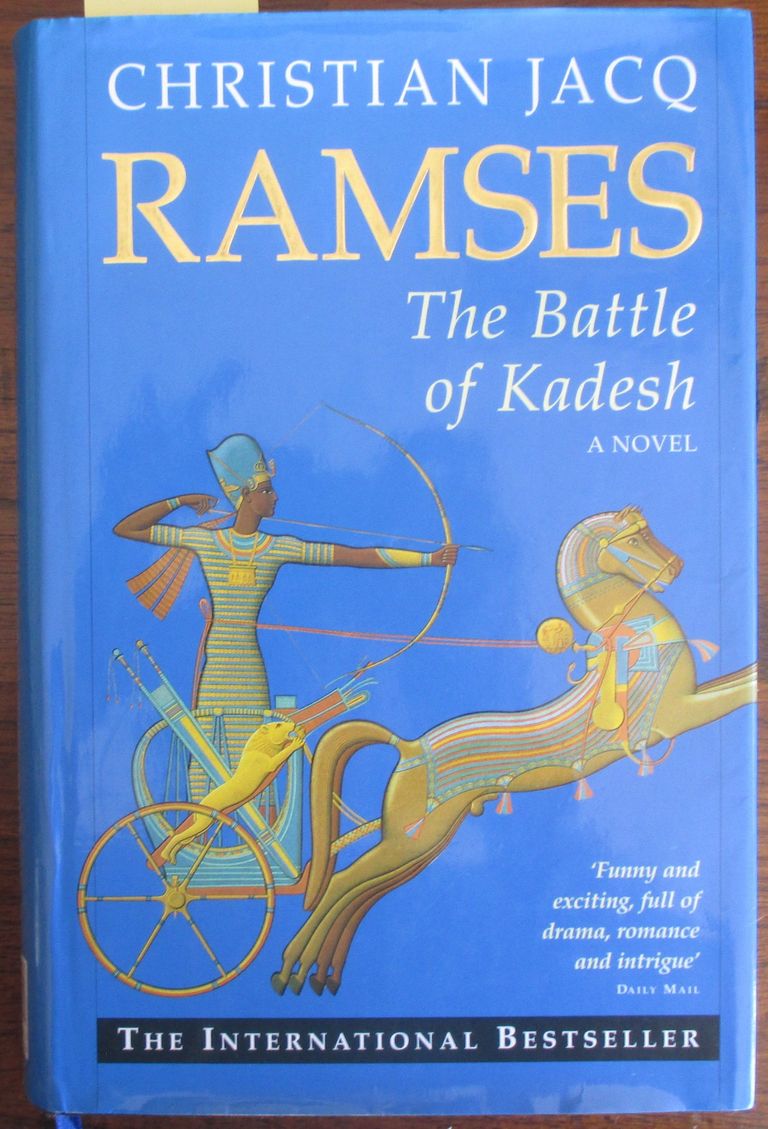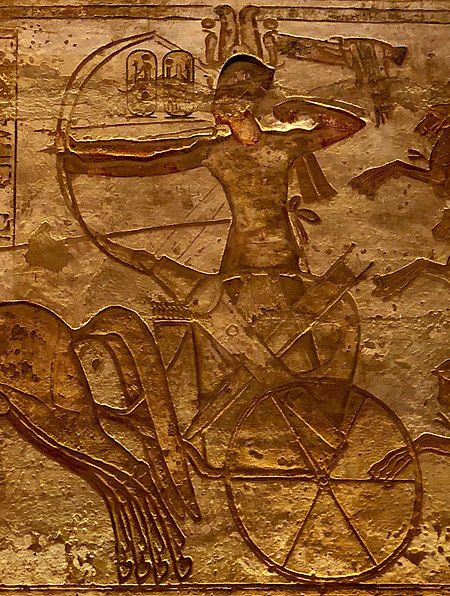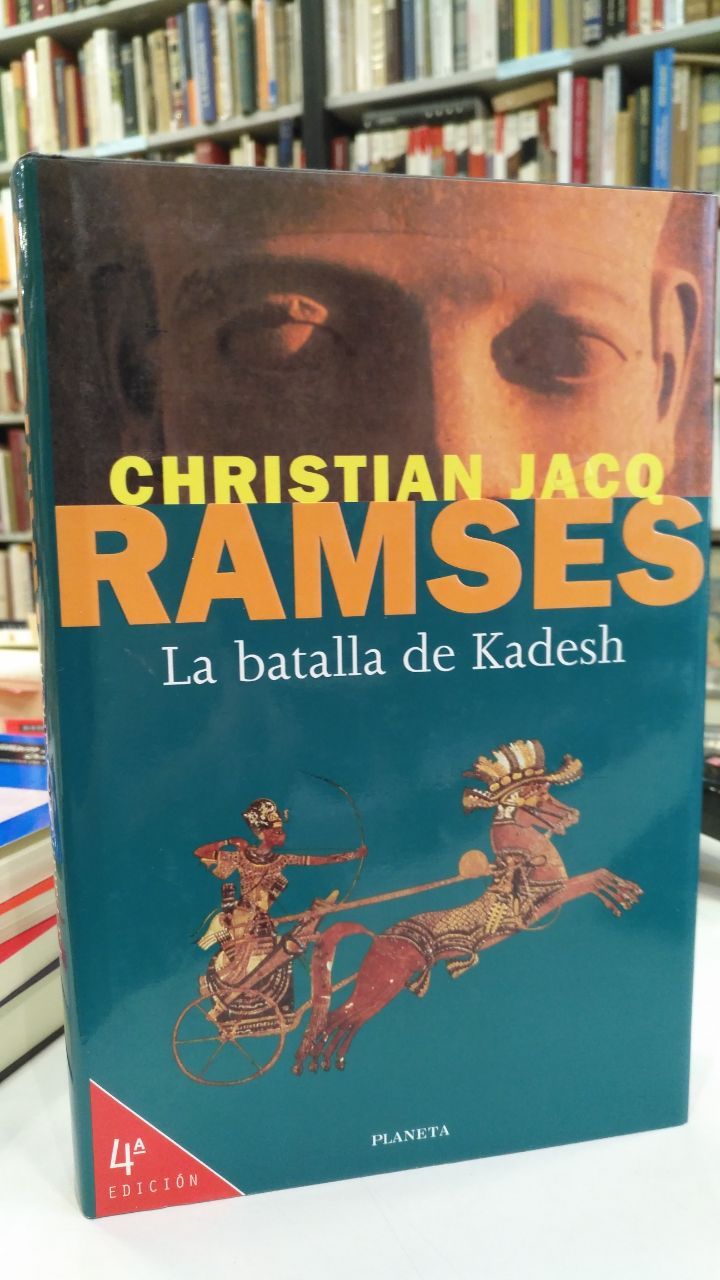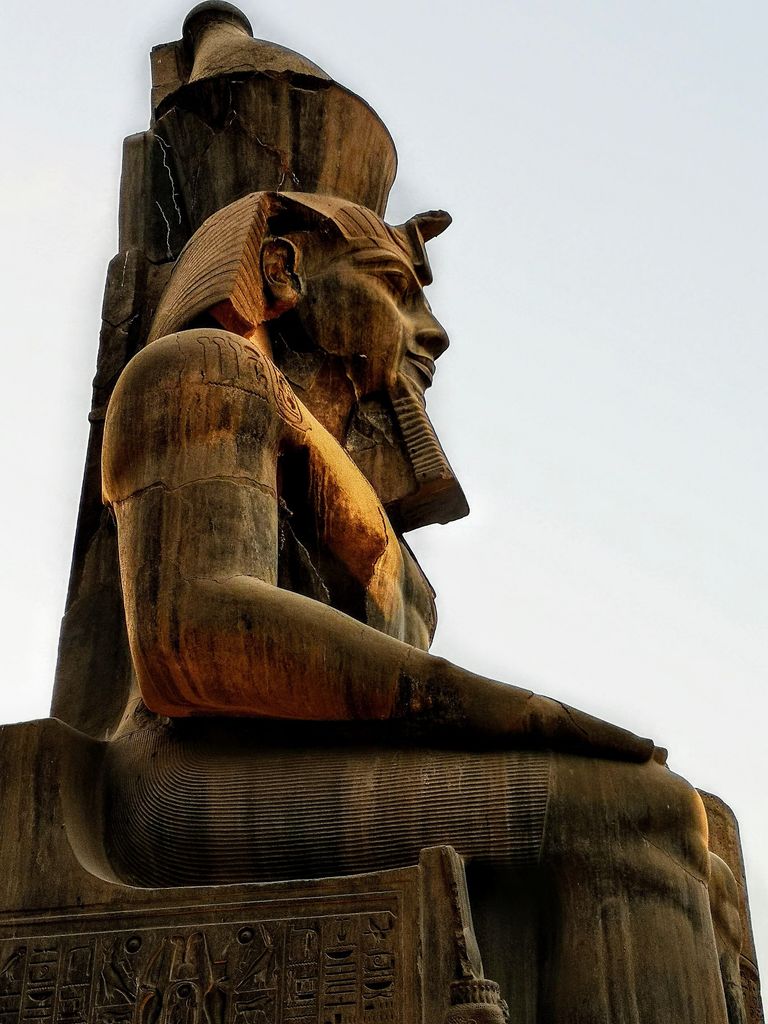
Today I am going to share with all the users of this beautiful literary community of BLURT a review of the third volume that Christian Jacq has dedicated to the best known of the pharaohs of Ancient Egypt: Ramses II, historically known as Ramses who left a profound legacy of civilization and culture to posterity, in an era in which barbarism and infighting were a recurring theme and the use of force considered a "normal" act.
Indeed, he was the opposite of a warrior monarch, and was one of the pharaohs who most relied on the application of the rules of Maath, the goddess of truth and justice, in whose honor he had several temples consecrated.
Supported in the negotiations by his wife Nefertari he built the basis of the peace treaty with the Hittites, true warrior people of that time (we are talking about the 12th century a.C.) who lived in the highlands of Anatolia (now Turkey) and that were a constant danger because crossing the Sinai desert reached near the Nile Delta trying to take possession of the riches that Egypt had: fertile lands, agriculture and livestock in the vicinity of the delta and deposits of precious minerals in the middle of the desert.

Hoy voy a compartir con todos los usuarios de esta hermosa comunidad literaria de BLURT una reseña sobre el tercer volumen que Christian Jacq ha dedicado al más conocido de los faraones del Antiguo Egipto: Ramses II, conocido histórico como Ramses que dejó un profundo legado de civilización y cultura a la posterioridad, en una era en la que la barbarie y las luchas intestinas eran un tema recurrente y e uso d ela fuerza considerado un acto "normal".
En efecto, era todo lo contrario a un monarca guerrero, y fue uno de los faraones que más confió en la aplicación de las reglas de Maath, la diosa de la verdad y la justicia, en cuyo honor hizo consagrar varios templos.
Apoyado en las tratativas por su esposa Nefertari construyó la base del tratado de paz con los hititas, verdadero pueblo guerrero de esa época (estamos hablando del siglo 0XII antes de Cristo) que habitaba en los altiplanos de Anatolia (actual Turquia) y que eran un peligro constante ya que atravesando el desierto del Sinaí llegaban hasta cercanías del Delta del Nilo tratando de adueñarse de las riquezas de que Egipto disponía: tierras fértiles, agricultura y ganadería en cercanías del delta y yacimientos de minerales preciosos en pleno desierto.


In this book entitled The Battle of Kadesh, Christian Jacq, Egyptologist, study and deep knowledge of all the mysteries of Ancient Egypt, graduated with a master's degree in this subject from the Sorbonne University, faces one of the issues on which has not been done, historically enough clarity: the Battle of Kadesh, a fortification built on the border of both territorial domains, in the middle of Canaan where both armies faced each other.
The Hittite commanded by the emperor Muwatalli and the Egyptian under the orders of Ramses.
Although it is one of the best documented battles of the history through the information gathered in papyri and bas-reliefs in the different monuments some doubt in attributing a victory to Ramses as the figures escorted in the monuments would evidence.
The most probable thing is that it has been a fight without a clear dominator as Jacq describes it in his book, where before a first violent Hittite attack Ramses manages to counterattack and to reject the invader that is entrenched inside the fort.
Faced with the impossibility of launching an attack against the impregnable walls of the fortification both reach an agreement and Ramses withdraws with his army. What was foreseen as a clear defeat at the beginning was considered, at the end, as a victory by the Egyptians.
According to historical data it is one of the largest battles fought in antiquity in which a total of between 5,000 and 6,000 assault chariots participated, plus the infantry and the archers of Ramses' elite special corps that with their large parabolic bows could reach an unusual distance with their arrows.

En este libro titulado La Batalla de Kadesh Christian Jacq, egiptólogo, estudio y profundo conocer de todos los misterios del Antiguo Egipto, egresado con un master en esta materia de la Universidad de La Sorbona, afronta uno de los temas sobre los cuáles no se ha hecho, históricamente suficiente claridad: la Batalla de Kadesh, una fortificación construída en el límite de ambos dominios territoriales, en pleno Canaan donde se enfrentaron ambos ejércitos.
El hitita comandado por el emperador Muwatalli y el egipcio a las órdenes de Ramsés.
Si bien es una de las batallas mejor documentadas de la historia a través de la información recogida en papiros y bajorelieves en los distintos monumentos algunos dudas en atribuir una victoria a Ramses como evidenciarían las figuras escolpidas en los monumentos.
Lo más probable es que haya tratado de una lucha sin un claro dominador como Jacq lo describe en su libro, donde ante un primer ataque violento hitita Ramsés logra contraatacar y rechazar el invasor que se atrinchera dentro del fuerte.
Ante la imposibilidad de lanzar un ataque contra los muros inexpugnables de la fortificación ambos llegan a un acuerdo y Ramsés se retira con su ejército. Lo que se preveeía como una clara derrota al inicio fue considerada, al final, como una victoria por los egipcios.
Según datos históricos es una de las batallas más grandes libradas en la antiguedad en la cuál participaron en total entre 5.000 y 6.000 carros de asalto, más la infantería y los arqueros cuerpo especial de elite de Ramses que con sus grandes arcos parabólicos podían llegar a una distancia inusitada con sus flechas.

The plot of the book begins with the Hittite threat that begins to gradually take over the Egyptian border posts in the Sinai Desert, subjecting the local princes and tribal chiefs to their will either with the use of force or with bribes and threats.
Egypt aware of this threat according to the reports of Asha head of diplomacy and with the experience of Serramanna the Sardinian ex-pirate whom Ramses spares not only his life but names him head of his personal guard, begins to rearm his army, accustomed to a long period of peace.
The war is approaching and Asha begins to play both sides. Threatened by the brother of Ramses, Chenar, he must pretend to act in coexistence with him plotting behind the Pharaoh's back, otherwise he will be eliminated.
The betrayal is nestled in the royal palace itself and has as representatives not only Chenar but nobles and representatives of the Egyptian upper class who plan a coup against Ramses, even at the cost of allying with a cruel and ruthless invader such as the Hittites.
Once completed the preparation of the army Ramses takes command of the troops and after leaving the command of the kingdom in the hands of his wife Nefertari, his mother Tuya and his faithful friend and private secretary Ameni, he heads towards Kadesh, in whose vicinity the army of Muwatali, commanded by his son Uri Teshup and his brother Hattusil, is encamped.
The diplomatic efforts carried out by the Hittite royal wife Puduhepa together with the Egyptian royal wife Nefertari have not been able to avoid the encounter.
After a first Hittite attack and when the luck seemed adverse to Ramses, the divine light of Amun and his lion Hunter, which he had saved as a cub and had now become a real war machine, is launched against the Hittite army accompanied by the rest of the troops who were already fleeing and managed to repel the Hittite onslaught to the fort of Kadesh.
Given the impossibility on the part of both armies to achieve a clear victory, both kings decide to establish a truce and continue with the peace negotiations, in which both queens will have a preponderant role. One of the conditions of the truce is the release of Asha who had been held captive in Hatti after the last espionage mission commissioned by Ramses.
Ramses returns to Egypt, is acclaimed by the people happy to have neutralized the Hittite threat, and has to face another enemy no less powerful: the magician Ophir who fights to establish a new dynasty that responds to a single God as advocated by the ancient Akhenaton who, for this reason, was cursed and erased from the sacred Egyptian texts.
To which is added the always intriguing brother Chenar clouded by hatred for his brother and his desire to reign.
The peace negotiations begin and Ramses, feeling enlightened by the gods, decides to build a temple for his wife Nefertari in Abu Simbel, on the border of Egypt with Nubia (present Siudan) as an offering to the gods to strengthen the karma of the royal couple and to ward off the evil powers of the various enemies that he is constantly forced to face.
Chenar is finally discovered and Ramses instead of condemning him to death (the sentence usually meant that the condemned had to drink a portion of cobra venom) decides to send him to hard labor.
During a sandstorm in the middle of the desert he manages to escape his jailers and flee.
Moses who after having killed a foreman who blackmailed the workers in the construction of the pyramids flees and settles with the tribe of Midian has a vision of God and decides to return to Egypt to free his compatriots, who are not slaves but ordinary workers, although they are not free to believe in their only God in a land of polytheists, where everyone believes in the God he wants.
Nefertari, who cannot have any more children as a result of an evil spell that left her sterile, asks Ramses to unite again with Iset, his first bride and at that time second royal wife, so that she can produce a new heir. The pharaoh, although reluctantly, accepts the proposal of his wife and his union with the beautiful Iset is born a second son, Merenptah also known by the name of Setna.
Between internal betrayals and his eagerness to consolidate peace with the Hittites with the tireless work of one of his childhood friends, the aristocratic Asha, who tries by all means to save his life, closes this third part of the series that Christian Jacq has dedicated to the most famous pharaoh of all time.

La trama del libro inicia con la amenaza hitita que comienza de a poco a adueñarse de os puestos fronterizos egipcios en el Desierto de Sinaí sometiendo a los prícipes y jefes de tribus locales a su voluntad ya sea con el uso de la fuerza o con sobornos y amenazas.
Egipto consciente de esta amenaza segón los informes de Asha jefe de la diplomacia y con la experiencia de Serramanna el ex-pirata sardo a quien Ramses perdona no solo la vida sino que lo nombre jefe de su guardia personal, comienza a rearmar su ejército, acostumbrado a un largo período de paz.
La guerra se acerca y Asha comienza a jugar a dos puntas. Amenazado por el hermano de Ramsés, Chenar, debe simular que actúa en convivencia con él tramando a las espaldas del faraón, caso contrario será eliminado.
La traición se anida en el mismo palacio real y tiene como representantes no solo a Chenar sino a nobles y representantes de la clase alta egipcia que planean un golpe de estado contra Ramses, ún a costo de aliarse con un invasor cruel y despiadado como son los hititas.
Una vez completada la preparación del ejército Ramsés toma el mando de las tropas y tras dejar el mando del reino en las manos de su mujer Nefertari, su madre Tuya y su fiel amigo y segretario particular Ameni, se encamina rumbo a Kadesh, en cuyas cercanías se ha acampado el ejército de Muwatali, comandado por su hijo Uri Teshup y su hermano Hattusil.
Los esfuerzos diplomáticos llevados a cabo por la esposa real hitita Puduhepa junto a la esposa real egipcia Nefertari no han podido evitar el encuentro.
Luego de un primer ataque hitita y cuando la suerte parecía adversa a Ramsés, éste la luz divina de Amón y de su león Cazador, al que había salvado de cachorro y que ahora se había convertido en una auténtica máquina de guerra, se lanza contra el ejército hitita acompañado del resto de las tropas que ya estaban huyendo y logran rechazar la embestida hitita hasta el fuerte de Kadesh.
Ante la imposibilidad por parte de ambos ejércitos de lograr una victoria clara, ambos reyes deciden establecer una tregua y seguir con las tratativas de paz, en las cuáles ambas reinas tendrán un papel preponderante. Una de las condiciones de la tregua es la liberación de Asha que había quedado cautivo en el Hatti luego de la última misión de espionaje encargada por Ramsés.
Ramsés vuelve a Egipto, es aclamado por el pueblo contento de haber neutralizado la amenaza hitita, y tiene que enfrentar a otro enemigo no menos potente: el mago Ofir que lucha por instaurar una dinastía nueva que responda a un solo Dios como preconizaba el antiguo Akhenaton que, por este motivo, fue maldecido, y borrado de los textos sagrados egipcios.
Al cuál se agrega el siempre intrigante hermano Chenar obnubilado por el odio a su hermano y sus deseos de reinar.
Comienzan las tratativas de paz y Ramsés, sientiéndose iluminado por los dioses, decide de construir un templo para su esposa Nefertari en Abu Simbel, al límite del Egipto con Nubia (actual Siudán) como ofrenda a los dioses para reforzar el karma de la pareja real y poder rechazar los poderes maléficos de los diversos enemigos que constantemente se ve obligado a afrontar.
Chenar es finalmente descubierto y Ramses en vez de condenarlo a muerte (le sentencia normalmente significaba que el condenado debía beber una porción de veneno de cobra) decide enviarlo a trabajos forzados.
Durante una tormenta de arena en pleno desierto logra escapar a sus carceleros y huir.
Moisés que luego de haber matado a un capataz que chantajeaba a los operarios en la construcción de las pirámides huye y se establece con la tribu de Madián tiene una visión de Dios y decide regresar a Egipto para liberar a sus compatriotas, que no son esclavos sino trabajadores ordinarios, aunque no son libres de creer en su único Dios en una tierra de politeístas, donde cada uno cree en el Dios que quiere.
Nefertari que no puede tener más hijos como consecuen cia de un maleficio que la dejado estéril pide a Ramsés que se una de nuevo a Iset, su primera novia y en ese momento segunda esposa real, para que pueda producir un nuevo heredero. El faraón, aunque a regañadientes, acepta la propuesta de su esposa y de su unión con la bella Iset nace un segundo hijo, Merenptah también conocido con el nombre de Setna.
Entre traiciones internas y su afán por consolidar la paz con los hititas con el incansable trabajo de uno de sus amigos de la infancia, el aristocrático Asha, a quien trata por todos los medios de salvarle la vida, se cierra esta tercera parte de la serie que Christian Jacq ha dedicado al faraón más famoso de todos los tiempos.

Passionate Egyptologist Christian Jacq, PhD in Egyptology at the Sorbonne, has received in France awards such as the Jean d'Heurs and the Prix des Maisons de la Presse, for his contribution to the historical dissemination of Ancient Egypt.
Apart from the Ramses series, he has written a saga dedicated to Ramses' youngest son, whom he initially called Merenpath and later renamed Prince Setna, always mixing fiction -especially in the part about the gods- with real history.
Almost always the stories about Egypt he has articulated in the form of sagas of three or books such as those dedicated to the Pyramid of Cheops, to the mysteries of Osiris or to The Secrets of the Stone of Light.

Apasionado egiptólogo Christian Jacq, doctorado en Egiptología en La Sorbona, ha recibido en Francia premios como premios como el Jean d'Heurs y el Prix des Maisons de la Presse, por su contribución a la divulgación histórica del Antiguo Egipto.
Aparte de la serie de Ramses ha escrito una saga dedicada al hijo menor de Ramsés que inicialmente llama Merenpath y luego rebautiza como príncipe Setna, mezclando siempre ficción -especialmente en la parte relativa a los dioses- con historia real.
Casi siempre las historias sobre Egipto las ha articulado bajo la forma de sagas de tres o libros como las dedicadas a la Pirámide de Keops, a los misterios de Osiris o a Los Secretos de la Piedra de la Luz.

Unlike so many other historical novels in which the plot has been left largely to the free will of the writer, in this saga, most of the data are relative, and the author's fantasy has been limited only to aspects of grammatical development and secondary actions.
That is the great merit of the book. It manages to trap the reader with an unfamiliar historical review, since most of us don't even remember these middle school textbooks.
It is true that it has the mystery of a civilization that has been inexplicably (almost) ignored by history and historians. Perhaps because of its African, i.e. non-Western, origin.
Other civilizations have enjoyed the favor of historians, such as the Greeks and Romans, and yet, in some respects, they had not even remotely reached the level of Egyptian civilization.
An example: when Ramses ruled Greece was far from being the intellectual power it later became; there were two fractions, Sparta and Athens, which fought fiercely against each other, disputing love and hatred between Achilles, Helen -who visited Ramses captive of Menelaus- and the poet Homer.
The Romans were divided warring factions and not even organized under the form of a State.
At that time Egypt not only practiced writing with geroglyphics (an art that today we could compare to Chinese or Arabic writing) of exquisite perfection, but also used advanced notions of medicine through natural herbs, promoted the sciences generally astral and had a group of technicians to control the floods of the Nile through marks (the so-called nilometers), used the fertilization of the land after the Nile floods left the mud on the surface and were totally hostile to the use of money preferring barter.

A diferencia de tantas otras novelas históricas en las cuáles el argumento ha sido dejado, en gran parte, al libre albedrío del escritor, en esta saga, la mayor parte de los datos son relaes, y la fantasía del autor se ha visto limitada solo a aspectos de desarrollo gramatica y a acciones secundarios.
Ese es el gran mérito del libro. Lograr atrapar al lector con una reseña histórica desconocida, ya que la mayor parte de nosotros ni siquiera se acuerda de estos textos de estudio de la escuela media.
Es cierto que cuenta con el misterio de una civilización que inexplicablemente ha sido (casi) ignorada por la historia y los historiadores. Tal vez por su origen africana, es decir no occidental.
Otras civilizaciones han gozado fel favor de los historiadores, como griegos y romanos, y sin embargo, en algunos aspectos, no habían alcanzado ni remotamente el nivel de la civilización egipcia.
Un ejemplo: cuando gobernaba Ramsés Grecia estaba muy lejos de ser la potencia intelectual en la que después se transformó, eran dos fracciones Esparta y Atenas que luchaban encarnizadamente entre si, disputándose amorios y odios entre Aquiles, Helena -quien visitó a Ramses cautiva de Menelao- y el poeta Homero.
Los romanos eran fracciones guerreras divididas y ni siquiera organizadas bajo la forma de Estado.
En esa época Egipto no solo practicaba la escritura con geroglíficos (un arte que hoy podríamos comparar a la escritura china o árabe) de una perfección exquisita, sino que además utilizaba nociones avanzadas de medicina a través de la hierbas naturales, promovía las ciencias generalmenta astrales y tenía un grupo de técnicos para controlar las crecidas del Nilo a través de marcas (los llamados nilómetros), usaban la fertilización de la tierra después que las crecidas del Nilo dejaban en superficie el fango y eran totalmente hostiles al uso del dinero prefiriendo el trueque.
Graciar por leer!
Thank you for reading!

Upvoted. Thank You for sending some of your rewards to @null. Read my last posts to make sure that BLURT burning is profitable for you. Before using this bot please make sure your account has at least 100 BP. Get more BLURT:
@ mariuszkarowski/how-to-get-automatic-upvote-from-my-accounts@ blurtbooster/blurt-booster-introduction-rules-and-guidelines-1699999662965@ nalexadre/blurt-nexus-creating-an-affiliate-account-1700008765859@ kryptodenno - win BLURT POWER delegation@ ctime/burn-bot-liquid-blurtThanks @ctime and congratulations for the work.